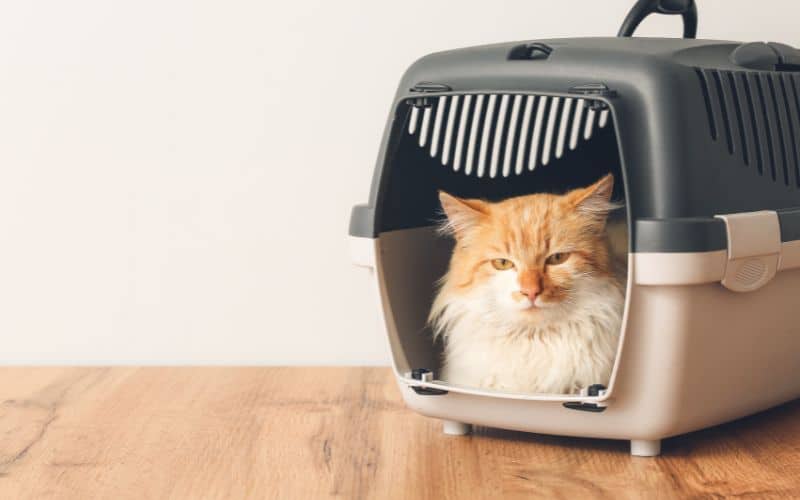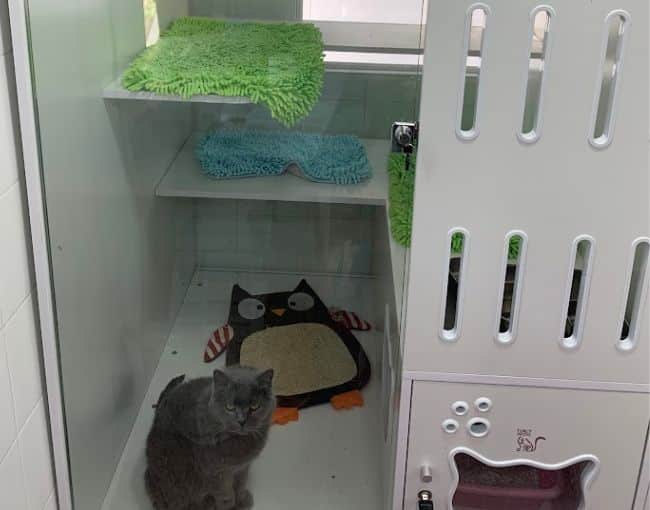Moving a cat to a new home requires careful planning to minimize stress. It’s not just about packing boxes and loading the moving truck; it’s about helping your feline friend transition safely from one territory to another. Unlike dogs, cats are entirely different when it comes to relocating to a new home. They are deeply attached to their familiar surroundings and scent-marked spaces. A sudden shift in environment can trigger elevated stress levels, anxiety, and even behavioural issues such as excessive meowing, hiding, or litter box avoidance. Whether you’re moving an indoor cat or an outdoor cat, the change in territory can be overwhelming without proper preparation.
The good news? With the right approach, you can turn a potentially stressful experience into a smooth, calm journey. In this guide, we’ll share 10 veterinarian-approved tips to help pet parents reduce anxiety, maintain a sense of comfort and control, and ease their kitty into a new home. From choosing the right cat carrier and packing familiar items to setting up a safe room in the new environment, these tips will ensure your pet’s transition is safe, gentle, and as stress-free as possible.
10 Expert Tips on Relocating a Cat to a New Home
Relocating cat to a new home can be a stressful experience not just for humans, but also for our feline companions. Cats are creatures of habit who find comfort in familiar surroundings, routines, and scents. A sudden change in environment can leave them feeling anxious, disoriented, or even fearful. To ensure a smoother transition, here are 10 practical advice to help your cat adjust comfortably to a new home.
1. Get Your Cat Used to a Carrier
A cat carrier is essential for transporting your pet safely, but many cats associate it with stressful trips to the vet. To change this perception, start crate training weeks before moving day by gradually introducing the carrier as a positive, safe space. Leave it open in your living space with a soft blanket and place treats, toys, or food inside. Allow your cat to explore it freely, and once they’re comfortable, begin taking them on short car rides. This desensitization will reduce anxiety during the actual move and make the journey more manageable for both of you.
2. Keep Your Cat’s Routine Consistent
Cats thrive on routine. Even during the upheaval of moving, it’s crucial to maintain a consistent daily schedule. Feed your cat at the usual times, engage in regular play sessions, and stick to familiar rituals like grooming or bedtime cuddles. Maintaining this consistency can help ease your cat’s stress and make them feel more comfortable during all the changes and shifting surroundings.
3. Introduce a Single Room First
When you arrive at your new home, don’t immediately give your cat free rein of the entire house. Instead, prepare a designated “safe room” for them. Furnish it with familiar items like their litter box, scratching post, food and water bowls, and favourite toys. This smaller, enclosed space allows your cat to slowly acclimate to the new smells and sounds without becoming overwhelmed. Once they seem comfortable and curious, you can gradually introduce them to other areas of the home.
4. Use Pheromone Sprays or Diffusers
Feline pheromone products like sprays or plug-in diffusers mimic the natural calming scents that cats produce. These products can help reduce anxiety and make your cat feel more secure in unfamiliar territory. Apply the pheromone spray to bedding, carriers, or blankets before and after the move, especially in areas your cat frequents. Many pet owners report noticeable improvements in their cat’s stress levels using these calming aids.
5. Keep Your Cat Mentally and Physically Stimulated
A bored or under-stimulated cat is more likely to exhibit behavioural issues like scratching furniture, aggression, or avoiding the litter box. Enrich your new space with interactive toys, climbing structures like cat trees, puzzle feeders, and cozy perches by windows. Engage your cat with daily play sessions to burn off nervous energy and encourage positive associations with their new home.
6. Maintain Patience and Offer Reassurance
Every cat adjusts at their own pace, so it’s important to remain patient and empathetic. Avoid forcing them to explore or interact before they’re ready. Spend quiet time nearby, blink slowly (a feline sign of trust), and speak in soft tones. Offer treats as positive reinforcement. By providing a calm and supportive environment, you’re helping your cat build confidence and trust in their new surroundings.
7. Consult a Veterinarian
Before the move, schedule a visit to your vet, especially if your cat has a history of anxiety, motion sickness, or medical concerns. A veterinarian can offer personalized advice and may recommend calming products or even short-term anxiety medication. They can also check your cat’s overall health to ensure they’re fit for travel and the transition. This professional support can make a significant difference in how well your cat handles the move.
8. Gradually Increase Access to the Rest of the House
Once your cat feels secure in the safe room, you can slowly introduce them to the rest of the house. Do this one room at a time, allowing your cat to explore at their own pace. Monitor their behaviour closely, and look for signs of fear or hesitation. Always leave the door to the original safe room open, so your cat can retreat there if they feel overwhelmed. This gradual expansion helps prevent stress and gives your cat a greater sense of control over their environment.
9. Monitor Eating, Litter Habits, and Behaviour Closely
During the first few days in a new home, it’s important to observe your cat’s eating, drinking, and litter box usage. Stress can cause some cats to stop eating or using the litter box properly. Watch for signs like hiding for long periods, excessive vocalization, or a lack of appetite. If any of these issues continue for more than 24–48 hours, consider consulting your vet. Early detection of behavioural or health issues can help ensure your cat adjusts safely and comfortably.
10. Update Identification and Support a Smooth Adjustment
Before relocating, make sure your cat’s microchip is registered with your current phone number and new home address. If your cat wears a collar, update the ID tags accordingly. During the first few weeks after moving, keep your cat indoors to reduce the risk of escape or attempts to return to their old home. Some cats may hide, meow excessively, or appear withdrawn; this is normal. Provide calm companionship, avoid punishment, and let them adapt at their own pace. If behavioural issues persist, consult a veterinarian or feline behaviourist for guidance.
How to Prepare Your New House for a Cat
Bringing a cat into your new home is an exciting step, but it also requires careful preparation. A well-prepared environment can make your cat feel safe, comfortable, and less stressed during the transition. Here are the key steps to take before introducing your cat to their new surroundings:
-
Do a Safety Check
Before your cat explores, inspect every room for possible dangers. Tuck away loose wires, block off small gaps where a cat could get stuck, and remove any toxic plants or exposed chemicals from cupboards. Secure windows and check that screens are properly fitted to prevent escapes or accidents. Your goal is to remove everything that could harm or trap a curious cat during the pet transition.
-
Set Up a Designated Space
Choose a quiet, cozy area where your cat can initially stay and feel safe. Set up their essentials here, including a bed, food and water bowls, a litter box, and a few favourite toys. Having a designated space helps them gradually adjust to unfamiliar sights, sounds, and smells in the new home for cats. Once your cat feels comfortable, you can gradually allow them to explore more areas of the new cat home.
-
Use Familiar Scent
Cats are highly scent-driven, so bring along familiar-smelling items from your old home to ease the transition. Gently rub soft materials like blankets or clothing on furniture at your previous residence and place those items around the new house. Incorporate your cat’s used toys, bedding, scratching posts, or even a small amount of used litter to make the space feel more familiar and comforting during the cat moving process.
-
Prep the Litter Box
Set up the litter box in a quiet, low-traffic area that’s easy for your cat to access. Use the same type of litter they’re accustomed to and avoid placing the box near food or water dishes. If you have a multi-level home, consider placing a litter box on each floor. Keep it clean and odour-free to encourage consistent use, especially in those first crucial days of relocating pets.
Common Mistakes to Avoid When Moving with Cats to a New Home
Relocating can be overwhelming for cats, who are creatures of habit and sensitive to change. While there are many tips on what to do, it’s equally important to know what to avoid. Here are five key mistakes to steer clear of when moving with your feline companion:
-
Don’t Sedate Your Cat Without Veterinary Advice
Using sedatives to keep your cat calm during a move might seem convenient, but it can be risky without professional guidance. Pet Sedation can impair your cat’s balance and natural instincts. Instead, speak with your vet about safe calming options, like pheromone sprays, anxiety-reducing supplements, or prescription solutions based on your cat’s needs.
-
Don’t Rush the Transition
Avoid giving your cat immediate access to the entire house. A new space can feel overwhelming. Start with a quiet, enclosed room filled with familiar items like their bed, litter box, toys, and food to help them feel secure. Once they seem relaxed and curious, gradually introduce them to other parts of the home.
-
Don’t Leave Doors or Windows Open
Cats are fast and sneaky, especially when stressed. On moving day, or while unpacking, be extra careful to keep all doors and windows closed. It’s easy for a startled cat to slip out unnoticed, so make sure their safe room is secure and inform everyone involved in the move to be cautious.
-
Don’t Introduce Other Pets Right Away
Even if your pets usually get along, introducing them to a new environment can create tension. Wait until your cat has settled into their new surroundings before making any introductions. When the time is right, reintroduce pets slowly using scent swapping, visual barriers, and supervised contact.
-
Don’t Change Food, Litter, or Routines Abruptly
Keep as many things familiar as possible. Now is not the time to switch up food brands or litter types, as this can cause stress-related issues like not eating or avoiding the litter box. Stick to your cat’s usual schedule and products for the first few weeks to help ease the transition.
Conclusion
Moving to a new home is an enormous change for your cat, but it doesn’t have to be a traumatic experience. With the right preparation such as getting your cat used to the carrier early, implementing crate training, maintaining consistent routines, and creating a calm environment, you can significantly reduce anxiety. These veterinarian-recommended tips offer reliable guidance to ensure that your feline friend stays safe, relaxed, and supported during every stage of the transition to a new home.
As a renowned pet relocation company, we specialize in hassle-free cat transportation designed with your pet’s well-being in mind. From door-to-door service and air travel coordination to climate-controlled transport and custom crates, we take care of every detail so you don’t have to. Our experienced team understands how to minimize stress, ensure comfort, and keep your cat secure throughout the move. Let us handle the logistics while you focus on settling into your new home with your beloved furry companion. Contact us today to learn more about our expert cat relocation services because your cat deserves a calm, caring move to their next home.
Click Here For Shipping Enquiry
Frequently Asked Questions
How long does it take for a cat to get used to a new home?
There's no set timeframe, but expect at least 1-2 months for your cat to feel comfortable and confident in new surroundings. Make the change easier by sticking to regular feeding times, keeping their bedding and toys the same, and giving them lots of affection.
How can I keep my cat calm on the moving day?
Use pheromone sprays and diffusers a few days before the move to help reduce stress. Also, stick to your cat's regular feeding and litter box cleaning routine as much as possible.
How should I transport my cat safely in the car?
Always put your cat in a well-ventilated carrier or crate secured with a seatbelt when travelling by car. Don't let them roam loose.
What should I set up for my cat in the new home first?
When you arrive in the new home, set up a small, quiet room with your cat's essentials like food, water, a litter box, a scratcher, a bed, and toys. Let your cat stay in this room for the first few days as they adjust to the new environment.
How do I introduce my cat to the new pets?
Introduce new pets slowly over two weeks. Exchange scents first by rubbing cloths on each animal.
Is it bad to move a cat from house to house?
Moving a cat from one house to another isn’t inherently bad, but it can be stressful for them. Cats are territorial animals that rely on familiar scents and routines, so relocation can cause anxiety, behavioral changes, or temporary health issues. With proper preparation and patience, however, most cats adapt well over time.
Can moving houses affect your cat?
Yes, moving houses can affect your cat’s emotional and physical well-being. Stress from unfamiliar sights, smells, and routines may lead to hiding, loss of appetite, increased vocalization, or litter box issues. Providing a safe space, keeping routines consistent, and offering reassurance can help minimize these effects.
Should I let my cat outside right after moving?
It’s best to keep your cat indoors for at least 2 to 4 weeks and ensure their ID tags and microchip are updated before allowing outdoor access.













